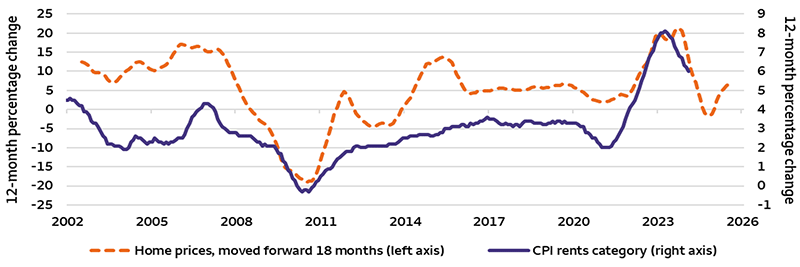April 23, 2024
Global Investment Strategy Team
Rental inflation suggests CPI likely to remain elevated
 Sources: Bloomberg and Wells Fargo Investment Institute. Monthly data, January 2002 – February 2024. Consumer Price Index (CPI) produces monthly data on changes in the prices paid by urban consumers for a representative basket of goods and services. Excerpted from Institute Alert (April 15)
Sources: Bloomberg and Wells Fargo Investment Institute. Monthly data, January 2002 – February 2024. Consumer Price Index (CPI) produces monthly data on changes in the prices paid by urban consumers for a representative basket of goods and services. Excerpted from Institute Alert (April 15)Why the rental component of the Consumer Price Index (CPI) is consequential for inflation
We recently increased our CPI inflation forecast for year-end 2024 and released our 2025 forecast.1 Both targets are now 3%, above the Federal Reserve’s (Fed) 2% long-term goal. We still anticipate a brief window of disinflation this year should economic growth gradually slow and allow the Fed to initiate rate cuts as we expect. However, we envision a slight firming of inflation once this pivot to lower rates spurs a modest economic recovery. Sticky, less economically sensitive CPI components also play a role — one notable example is rental inflation, which accounts for nearly one third of the CPI.
The above chart shows the historically long lag between home prices and rents, comparing the year-ago percent change in U.S. home prices (moved forward 18 months) with the year-ago percent change in rental inflation. Rents have typically followed home prices with a 12- to 18-month lag, so the data suggests the latest upturn in home prices likely will presage higher rental inflation in 2025, reinforced by slower growth of apartment supply later this year.
What it may mean for investors
Rental disinflation in 2023 was driven by a deceleration in home-price gains along with a temporary bulge in apartment construction, but we see these drivers as having since reversed. We think firmer rental inflation into 2025 is one of several factors that will keep inflation above the Fed’s 2% target, increasing upside risk to interest rates that could hamper growth. That reinforces our preference for more defensive portfolio positioning and makes the timing of future adjustments dependent on the interplay between economic activity, interest rates, and financial conditions.
1 Our CPI targets are calculated as a year-over-year percent change (from December to December).
Risk Considerations
Forecasts, estimates, and projections are not guaranteed and are based on certain assumptions and views of market and economic conditions which are subject to change.
General Disclosures
Global Investment Strategy (GIS) is a division of Wells Fargo Investment Institute, Inc. (WFII). WFII is a registered investment adviser and wholly owned subsidiary of Wells Fargo Bank, N.A., a bank affiliate of Wells Fargo & Company.
The information in this report was prepared by Global Investment Strategy. Opinions represent GIS’ opinion as of the date of this report and are for general information purposes only and are not intended to predict or guarantee the future performance of any individual security, market sector or the markets generally. GIS does not undertake to advise you of any change in its opinions or the information contained in this report. Wells Fargo & Company affiliates may issue reports or have opinions that are inconsistent with, and reach different conclusions from, this report.
The information contained herein constitutes general information and is not directed to, designed for, or individually tailored to, any particular investor or potential investor. This report is not intended to be a client-specific suitability or best interest analysis or recommendation, an offer to participate in any investment, or a recommendation to buy, hold or sell securities. Do not use this report as the sole basis for investment decisions. Do not select an asset class or investment product based on performance alone. Consider all relevant information, including your existing portfolio, investment objectives, risk tolerance, liquidity needs and investment time horizon. The material contained herein has been prepared from sources and data we believe to be reliable but we make no guarantee to its accuracy or completeness.
Wells Fargo Advisors is registered with the U.S. Securities and Exchange Commission and the Financial Industry Regulatory Authority, but is not licensed or registered with any financial services regulatory authority outside of the U.S. Non-U.S. residents who maintain U.S.-based financial services account(s) with Wells Fargo Advisors may not be afforded certain protections conferred by legislation and regulations in their country of residence in respect of any investments, investment transactions or communications made with Wells Fargo Advisors.
Wells Fargo Advisors is a trade name used by Wells Fargo Clearing Services, LLC and Wells Fargo Advisors Financial Network, LLC, Members SIPC, separate registered broker-dealers and non-bank affiliates of Wells Fargo & Company.
